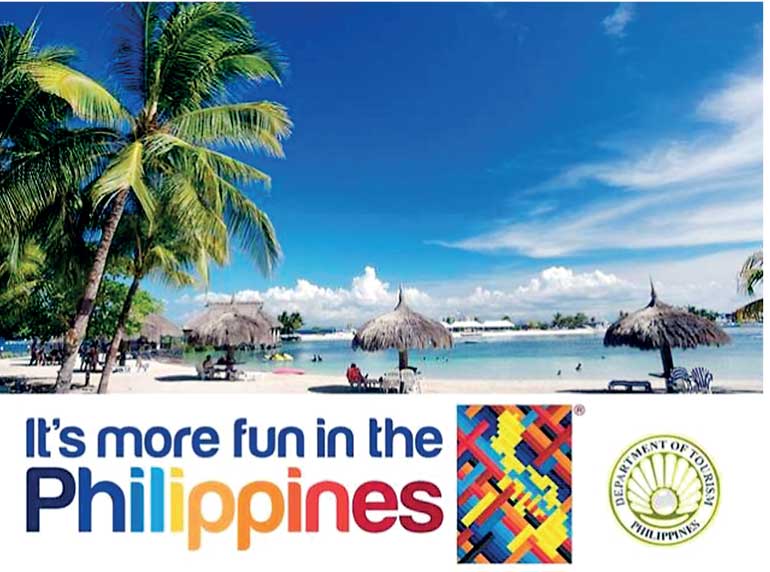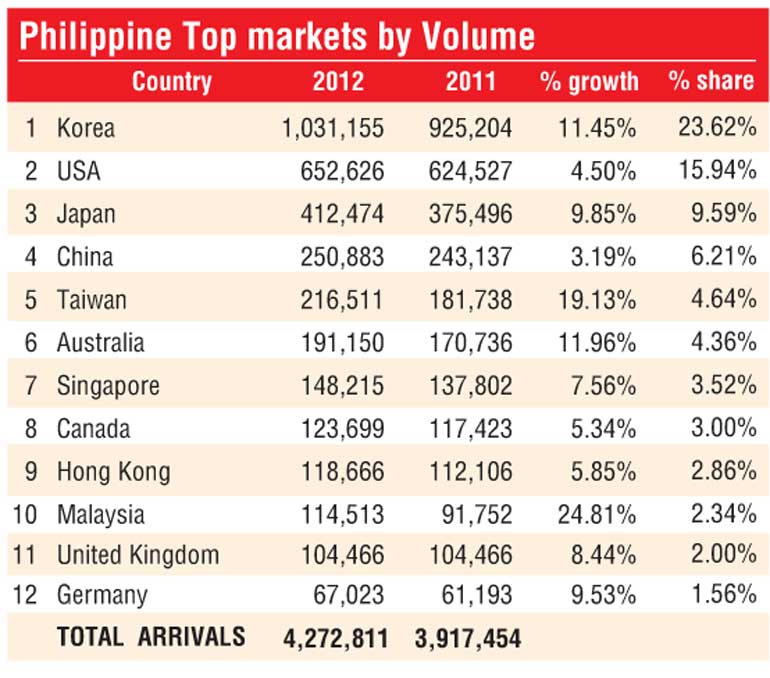Thursday Jan 23, 2025
Thursday Jan 23, 2025
Tuesday, 27 September 2016 00:04 - - {{hitsCtrl.values.hits}}
Given the celebration of tourism week, it is interesting to study the different practices of countries in driving tourism strategy. One case study which emerged showing a destination which drove the basics of business - Segmentation, Targeting and Positioning (STP) – was the Philippines. Let me delve deeper into its strategy.

The Philippines is a sovereign island nation in Southeast Asia situated in the western Pacific Ocean. The Philippine islands are an archipelago of over 7,000 islands lying about 805 km off the southeast coast of Asia. The overall land area is comparable to that of Arizona. Only about 7% of the islands are larger than one square mile, and only one-third have names. The largest are Luzon in the north (104,687 sq km), Mindanao in the south (94,631 sq km) and Visayas (61,077 sq km). The islands are of volcanic origin, with the larger ones crossed by mountain ranges. The highest peak is Mount Apo (2,954 m) on Mindanao.
Its location on the Pacific Ring of Fire close to the equator makes the Philippines prone to earthquakes and typhoons, but also endows it with abundant natural resources and some of the world’s greatest biodiversity. At approximately 300,000 sq km, the Philippines is the 72nd largest country in the world.
With a population of more than 100 million people, the Philippines is the seventh most populated country in Asia and the 12th most populated country in the world. An additional 12 million Filipinos live overseas, comprising one of the world’s largest diasporas. Multiple ethnicities and cultures are found throughout the islands.
The Philippines’ economy is the 39th largest in the world, with an estimated 2014 gross domestic product (nominal) of $ 289.686 billion. Primary exports include semiconductors and electronic products, transport equipment, garments, copper products, petroleum  products, coconut oil and fruits. Major trading partners include the United States, Japan, China, Singapore, South Korea, the Netherlands, Hong Kong, Germany, Taiwan and Thailand.
products, coconut oil and fruits. Major trading partners include the United States, Japan, China, Singapore, South Korea, the Netherlands, Hong Kong, Germany, Taiwan and Thailand.
Tourism is an important sector for the Philippine economy, contributing 7.8% to Philippine gross domestic product (GDP) in 2014. The Philippines is an archipelagic country composed of 7,107 islands with 82 provinces divided into 18 regions. The Philippines is known for its rich biodiversity and it is the main tourist attraction in the country. Its beaches, mountains, rainforests, islands and diving spots are among the country’s most popular tourist destinations. The country’s rich historical and cultural heritage is also one of its attractions.
In 2000, the Philippines’ tourist arrivals totalled 2.2 million. In 2003, it totalled 2,838,000, a growth of almost 29%, and was expected to grow to as much as 3.4 million in 2007. In the first quarter of 2007, tourist arrivals in the Philippines grew by as much as 20% in the same period as the previous year. In 2011, the Department of Tourism recorded that 3.9 million tourists visited the country, 11.2% higher than the 3.5 million registered in 2010.
Popular destinations among tourists include El Nido in Palawan, Boracay, Cebu and Manila. In 2012, the Philippines recorded 4.27 million tourist arrivals after the Department of Tourism launched a widely publicised tourism marketing campaign entitled ‘It’s More Fun in the Philippines’. In 2014, the Department of Tourism announced that 2015 would be the Visit the Philippines year.
There was a 1.53% increase in visitors in 2008 and a goal has been set of five million tourists from overseas by 2010 when it is hoped that tourism employment would have doubled to six million and tourists will constitute 13.6% of GDP in contrast to 7% in 1998. Asia supplies the highest proportion of visitors, led by South Korea and Japan, which together with the US accounted for almost half of the total in 2008. The importance of Philippine passport-holders permanently residing abroad, excluding overseas workers, should not be overlooked.
About 45% of all tourists travel for holiday purposes, 26.5% to visit friends and relatives and 16.9% for business. There is an uneven spread and Metro Manila, Tagatay on the island of Luzon, Cebu Province and Boracay Island are the preferred destinations. It should be noted that domestic tourism is also growing.

The Philippines’ overall GDP contribution from tourism stands at 7% to the $ 290 billion economy with around 3.5 million people directly employed. The average time spent by a visitor is eight days at around $ 672 spent per capita. Tourist arrivals have increased from one million in 1996 to 5.3 million by the end of 2015 which is interesting since Sri Lanka from just 0.5 million has become a two-million destination within just six years.
The essence of the strategy of the Philippines is their segmentation and targeting strategy. The top key markets of South Korea, the US, Japan, China, Taiwan and Australia give us an idea of the potential the markets have for earning. Some can argue that it is geography which drives tourism to a country but maybe further research is required to justify this thinking.
Against the backdrop of the overall marketing strategy, overall policy hinges on the following:
On the above framework, 21 strategic thematic tourism destination clusters covering 77 tourism areas have been identified for development.
While there are many lessons for Sri Lanka, what must be kept in mind is that every country's tourism strategy is linked to its culture. I still remember the words of World Tourism Organization (UNWTO) Secretary General Taleb Refai, “Culture drives tourism and it is not the other way round.”